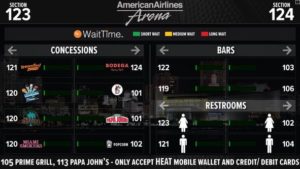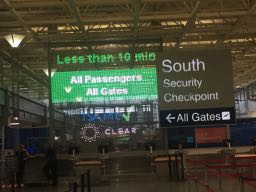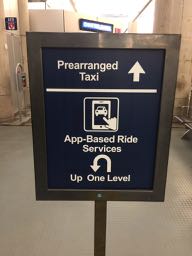Though we make it a point here at MSR to report as much as we can on app-based developments for stadiums, increasingly these days when at a game I find that many times it is simply not convenient to pull up information on my phone, especially so with wayfinding. Let’s leave aside wayfinding apps and beacons for a minute and ask — why, in this age when we can deliver personalized information to a phone, isn’t there more being done with large, video-based signage?
Give me direction, not just live action
Editor’s note: This column is from our most recent STADIUM TECH REPORT for Winter 2017-18, which is available for FREE DOWNLOAD from our site. This issue has an in-depth look at the wireless networks at U.S. Bank Stadium in Minneapolis, home of the upcoming Super Bowl 52, as well as profiles of network deployments at the brand-new Little Caesars Arena and Orlando City Stadium! DOWNLOAD YOUR FREE COPY today!
For sponsors and advertising, the revolution over the past few years of LED boards replacing static signage is like moving from telegraph to radio. Stadiums everywhere are pushing each other to see who can add more in the way of ribbon boards, big LED screens on concourses, on walls and of course, to see who can come up with the latest in big main video boards.
But even as it’s great that video screens are proliferating inside venues — you may never miss a live play anywhere inside a stadium again, including inside elevators — I would argue that in many stadiums, the strategy behind mounting signs and putting relevant content on them is still in its infancy, especially when it comes to things like updated wayfinding.
And while I doubt any of us really wants a future like the one depicted in Minority Report, where signs detect you and show you personalized marketing as you walk by, wouldn’t it be nice if the screens did more instead of just showing live action and synchronized ads? How about some proactive wayfinding, with time-sensitive messages, to help fans find what they need inside the stadium walls? With quick, easy to digest information that doesn’t require three clicks to find?
My beef with wait time apps and wayfinding
If there’s one loudly touted stadium app feature I’ve never fully bought into, it’s the whole “you can see how long the bathroom line is” app. Though it seems simple and good (and many reporters write about it without questioning it), I see a bunch of holes poking through that are never described in the press releases. First and most telling is that even with multiple versions of this service launched, nobody has yet provided us with any stats on usage, even though we’ve asked politely.

Picture of a monitor at American Airlines Arena, showing wait time information (not during a game). Credit: Miami Heat
One reason I don’t think wait time apps are a powerful idea for crowded stadiums is the simple fact that sometimes it’s not safe to be looking at your device. At a recent Vikings game at U.S. Bank Stadium I got a refresher — if you are walking on a concourse during a sellout game, the last thing you want to do is pull out your phone and be a gaper snce you might get gored by some guy with three-foot horns on his head who plows into you when you stop suddenly. Blue-dot directions are great in theory but like texting while driving, in some situations trying to stare at your phone may be hazardous to your health.
How about using the app while sitting in your seat, before you leave for the restroom? My question to the app provider is — what guarantee do you provide that if I start toward the bathroom with the shortest line, that it will still be short when I get there? And paradoxically, if more fans start using the app the way I am, won’t that make the short lines instantly long if we all head there at the same time?
More questions: Do any of these things tell you how long it will take you to walk to and from the bathroom with the shortest line? Or is it smarter to wait instead of walking (especially with a full bladder)? Are wait time apps smart enough to figure all this out? I doubt it.
But here is where smarter signs with more limited options come into play. Like the huge neon words in the Minneapolis airport, more interactive displays could go a long way in wayfinding, especially if they are only trying to do a small number of simple things, like, “SHORTER BATHROOM LINE 100 FEET THIS WAY,” or, “HOT DOG AND A BEER FOR $10, AT NEXT TWO STANDS.” I see a big difference in how such signs could differ from an app, by providing just the last piece of information in a process already begun — without any need for click-throughs.The Miami Heat are starting down this path, with video screens that face the fans when they come up from the stands at American Airlines Arena, with restroom and concession information (with simple arrows) provided by partner WaitTime. While we haven’t yet interviewed the folks at WaitTime to find out exactly how their sensors and algorithms stand up to our previous list of questions, our guess is that many more fans will find the information via the concourse displays than through any team app, simply because A) many team apps still aren’t well known or well used, and B) everyone pretty much knows how to read a sign.
This is what I mean when I say we need more tech for signs — the updated information is great stuff, but it doesn’t even have to be that digital. At Golden 1 Center in Sacramento there was an incredibly smart decision made to turn some concession signs on the concourse a simple 90 degrees — so you can read the sign while you are walking, without having to turn your head. It’s one of those things that when you see it for the first time, you wonder why we ever did it the other way.
Maybe what is needed are some new form factors, other than the standard horizontal TV screen. The Mall of America (story coming soon!) has some new interactive directories that are more like a big iPad than the old movie-poster models, and they are already reporting millions of user sessions and great feedback from guests. Why not install a bunch of smaller screens in stadiums and other large venues, which could be programmed for specific time-sensitive information?
Instead of one large screen with impossible to read small type about baggage-carousel information about your arriving flight, why not a monitor with BIG type that circles through the most recent flights, mounted above wherever you enter the baggage area? How about big arrows in stadiums as a game finishes, directing fans to less-crowded exits?
Where are we with this issue now? After Levi’s Stadium opened a few years ago, they had stadium employees with handheld signs after games, trying to direct fans to the light rail. In the Minneapolis airport, trying to find the Uber pickup area requires a treasure hunt of sorts, as you have to find and consult multiple portable printed signs to finally find the curbside spot. And at the Denver airport they use similar portable printed signs to direct passengers to quicker security lines. C’mon man. Time to tech up.
Maybe, yes, an app with blue-dot wayfinding could help here but in many real-life big-venue situations — a sellout crowd concourse, or hauling your carryon suitcase to the gate — taking your phone out is sometimes the least attractive option. Instead, let’s see some more tech directed to signs and the strategy behind their placement and content. Let’s call them signs of the times, shall we?








